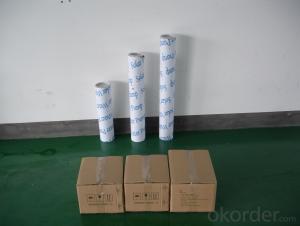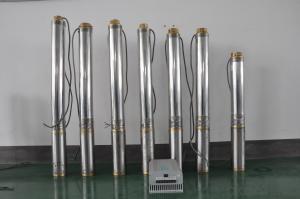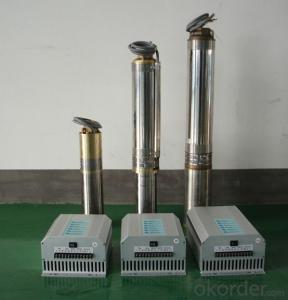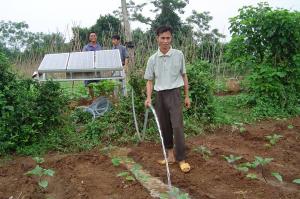DC Water Pumps
- Loading Port:
- China Main Port
- Payment Terms:
- TT OR LC
- Min Order Qty:
- -
- Supply Capability:
- -
OKorder Service Pledge
OKorder Financial Service
You Might Also Like
Item Description :
This superb new addition to our solar fountain range comes with a 10w solar panel,and a powerful fountain pump that is capable of producing fountains of up to 2m in height. As well as being easy to set up and use.Instruction manual is supplied for assembly and maintenance.
Solar Fountain Key Features :
Powered by direct sunlight
No high voltage electric mains required
Safe for children
Max. height of fountain: 2M
Max. flow capacity: 800 L/H(176 GAL)
10W Polycrystalline solar panel included
18V DC brushless pump
Solar Pump Features :
Can produce fountains up to : 2M (tube height) 1.4M (fountain height)
Comes with multiple nozzle accessories
Cable Length : 5M
Solar Panel Features :
10W peak power.
Polycrystalline highly efficient solar panel
Comes mounted in aluminium frame
Comes with ground stake and rotating knob so you can angle your panel toward the sun
What You Will Get :
10W solar panel
Solar pump
Ground Sake
Nozzle accessories
Precautions :
DO NOT alter or change the product itself or its components
Operate pump in freshwater only, never above 50 degrees celsius
Keep away from flammable liquids
Do not connect to any other power supply other than the included
- Q:Is it possible to retrofit an existing pump system with solar power?
- Yes, it is possible to retrofit an existing pump system with solar power. By installing solar panels and connecting them to the pump system, the pump can be powered by the energy generated from the sun. This allows for a sustainable and cost-effective alternative to traditional electricity sources.
- Q:Can a solar pump be used for water supply in off-grid research stations?
- Yes, a solar pump can be used for water supply in off-grid research stations. Solar pumps are powered by solar energy, making them a sustainable and efficient solution for remote locations without access to traditional grid electricity. They can effectively pump water from wells, rivers, or other water sources, providing a reliable water supply for research stations without the need for external power sources.
- Q:Can a solar pump be used in areas with limited access to training programs for maintenance?
- Yes, a solar pump can be used in areas with limited access to training programs for maintenance. Solar pumps are designed to be low maintenance and require minimal technical expertise for installation and operation. They are built with durable materials and often come with detailed user manuals that provide step-by-step instructions for maintenance. Additionally, there are online resources and communities where people can find guidance and support for troubleshooting and repairs. Thus, even in areas with limited access to training programs, individuals can still effectively maintain and operate solar pumps.
- Q:Are there any noise restrictions for installing a solar pump in residential areas?
- Yes, there may be noise restrictions for installing a solar pump in residential areas. It is advisable to consult local authorities or check with the homeowner's association to determine any specific regulations or requirements regarding noise levels for such installations.
- Q:Can a solar pump be used in remote areas?
- Yes, a solar pump can be used in remote areas. Solar pumps are powered by sunlight, making them ideal for locations that are not connected to the traditional power grid. They can provide a reliable and sustainable source of water supply in remote areas, reducing the dependency on fuel-based generators or long power transmission lines. Additionally, solar pumps require minimal maintenance and have a long lifespan, making them a cost-effective solution for remote communities.
- Q:Can a solar pump be used for water supply in horticulture farms?
- Yes, a solar pump can be used for water supply in horticulture farms. Solar pumps are an environmentally friendly and cost-effective solution for irrigation in farms, as they utilize solar energy to power the pump and provide water for irrigation. This eliminates the need for grid electricity or fuel, thus reducing operational costs and carbon emissions. Additionally, solar pumps can be easily installed and operated in remote areas where grid electricity is not available, making them an ideal choice for water supply in horticulture farms.
- Q:Can solar pumps be used for water supply in hotels or resorts?
- Yes, solar pumps can certainly be used for water supply in hotels or resorts. Solar pumps provide a sustainable and cost-effective solution for water pumping, offering reliable operation and reducing the dependence on traditional electricity sources. They can effectively meet the water demand of hotels or resorts, ensuring a continuous and eco-friendly water supply.
- Q:Can a solar pump be used in remote areas without access to electricity?
- Yes, a solar pump can be used in remote areas without access to electricity. Solar pumps are designed to operate using solar energy, which means they can function even in areas where there is no grid power or electricity infrastructure. They are an ideal solution for remote locations, providing a reliable and sustainable source of water without the need for electricity.
- Q:Can a solar pump be used for water supply in military bases or camps?
- Yes, a solar pump can be used for water supply in military bases or camps. Solar pumps are a reliable and efficient solution as they harness solar energy to power the pump, eliminating the need for traditional electricity sources. This makes them ideal for remote locations where access to electricity might be limited. Solar pumps can provide a sustainable and cost-effective water supply, supporting the water needs of military personnel in bases or camps.
- Q:How does the energy usage of a solar pump system vary with different pumping depths?
- Different pumping depths can lead to varying energy usage in a solar pump system. Typically, the deeper the pumping depth, the more energy is necessary to pump water. This is due to the fact that as the water level decreases, the pressure head increases, which demands more effort from the pump. In a solar pump system, solar panels play a crucial role in generating energy. These panels convert sunlight into electricity to power the pump. The amount of energy produced by the solar panels is influenced by factors such as the presence of sunlight, panel efficiency, and any shading or obstructions that might affect the panels' output. When it comes to pumping water from different depths, the energy usage of the solar pump system is impacted by two primary factors: the vertical distance the water needs to be pumped (referred to as the pumping head) and the horizontal distance the water needs to be pumped (known as the pumping distance). The pumping head is directly related to the depth of the water source. As the depth increases, so does the pumping head, requiring the pump to exert more energy to lift the water against gravity. Consequently, this results in higher energy consumption. Similarly, the pumping distance can also affect the energy usage of a solar pump system. The greater the horizontal distance the water needs to be pumped, the more energy is necessary to overcome friction losses in the pipes. In conclusion, it can be inferred that the energy usage of a solar pump system generally rises with greater pumping depths. However, it is important to note that advancements in solar panel technology and pump efficiency can help optimize energy consumption and minimize the impact of pumping depth on energy usage.
1. Manufacturer Overview |
|
|---|---|
| Location | |
| Year Established | |
| Annual Output Value | |
| Main Markets | |
| Company Certifications | |
2. Manufacturer Certificates |
|
|---|---|
| a) Certification Name | |
| Range | |
| Reference | |
| Validity Period | |
3. Manufacturer Capability |
|
|---|---|
| a)Trade Capacity | |
| Nearest Port | |
| Export Percentage | |
| No.of Employees in Trade Department | |
| Language Spoken: | |
| b)Factory Information | |
| Factory Size: | |
| No. of Production Lines | |
| Contract Manufacturing | |
| Product Price Range | |
Send your message to us
DC Water Pumps
- Loading Port:
- China Main Port
- Payment Terms:
- TT OR LC
- Min Order Qty:
- -
- Supply Capability:
- -
OKorder Service Pledge
OKorder Financial Service
Similar products
New products
Hot products
Hot Searches
Related keywords



























